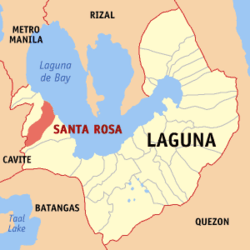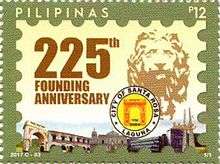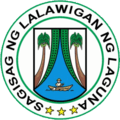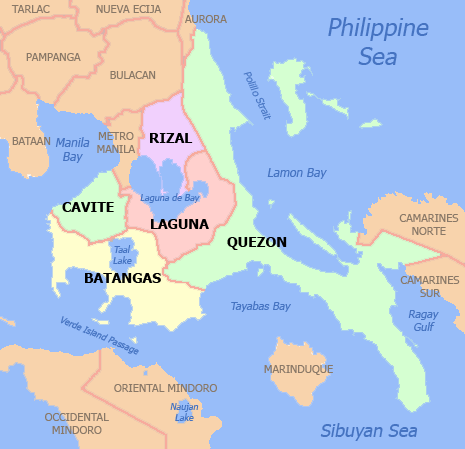Santa Rosa, Laguna
| Santa Rosa | ||
|---|---|---|
| Component City | ||
| City of Santa Rosa | ||
|
Downtown area | ||
| ||
 Map of Laguna with Santa Rosa highlighted | ||
.svg.png) Santa Rosa Location within the Philippines | ||
| Coordinates: 14°19′N 121°07′E / 14.32°N 121.12°ECoordinates: 14°19′N 121°07′E / 14.32°N 121.12°E | ||
| Country |
| |
| Region | Calabarzon (Region IV-A) | |
| Province | Laguna | |
| District | 1st District | |
| Founded | January 18, 1792 | |
| Cityhood | July 10, 2004 | |
| Barangays | 18 (see Barangays) | |
| Government [1] | ||
| • Type | Sangguniang Panlungsod | |
| • Mayor | Danilo Fernandez | |
| • Vice Mayor | Arnold B. Arcillas | |
| • Electorate | 181,664 voters (2016) | |
| Area [2] | ||
| • Total | 54.84 km2 (21.17 sq mi) | |
| Elevation | 20.3 m (66.6 ft) | |
| Population (2015 census)[3] | ||
| • Total | 353,767 | |
| • Rank | 2 out of 30 (in Laguna)[4] | |
| • Density | 6,500/km2 (17,000/sq mi) | |
| Time zone | UTC+8 (PST) | |
| ZIP code | 4026 | |
| PSGC | 043428000 | |
| IDD : area code | +63 (0)49 | |
| Climate type | Tropical monsoon climate | |
| Income class | 1st city income class | |
| Revenue (₱) | 2,302,416,040.75 (2016) | |
| Native languages |
Tagalog Taglish Swardspeak | |
| Website |
www | |
Santa Rosa, officially the City of Santa Rosa, (Tagalog: Lungsod ng Santa Rosa), or simply known as Santa Rosa City, is a 1st class city in the province of Laguna, Philippines. According to the 2015 census, it has a population of 353,767 people.[3]
It is the second largest local government unit in Laguna after Calamba.[3] Nowadays, it is the seat of the First District Representative of Laguna.
Santa Rosa was initially known for the Coca-Cola and Toyota manufacturing plants in its industrial estates. Recently, it has also become popular for being the site of Enchanted Kingdom, a local theme park; as well as several housing developments. This city contains the 3rd largest complex in Laguna, Paseo de Santa Rosa. Santa Rosa became a city by virtue of Republic Act No. 9264,[5] which was ratified by its residents on July 10, 2004.
History

In 1571, Spanish conquistador Juan de Salcedo, the grandson of Miguel López de Legazpi, founded the town of Biñan which was annexed as a barrio to Tabuco (now, Cabuyao) while exploring the region of Laguna de Bay.
In 1688, Biñan, together with Barrio Bukol (Santa Rosa, before separation from Biñan) separated from Cabuyao. After a series of renaming, separation of barrios to become independent towns, Barrio Bukol was politically emancipated as the municipality of Santa Rosa. The town was renamed after Saint Rose of Lima. The municipality of Santa Rosa was founded on January 18, 1792.
During the revolutionary period in 1898, the town was instrumental in the proclamation of Philippine independence from Spain when it signed the Act of Independence on June 12, 1898. Later on the town's local revolutionaries fought alongside the forces of Pío del Pilar during the Philippine–American War.
On February 5, 1945, the town was left abandoned by the Japanese soldiers when the local guerrilla resistance movement, with support from the American and Filipino military contingent, entered the town proper, where skirmishes, torture, and deaths occurred.
During the post-war era, until the 1970s, the townspeople were largely dependent on basic agriculture and family-owned enterprises for livelihood. The influence of industrialization slowly took shape in the 1980s with the entry of local and foreign investors who were instrumental in the fast-pace economic and social transformation of the town and the province.
Geography
Santa Rosa's land area is approximately 54.13 square kilometers (5413 hectares). It is in the western section of Laguna de Bay.
The western portion of the city occupies the numerous commercial, industrial, and business establishments, while the northern portion is primarily composed of residential areas and subdivisions, schools, industrial zones and various business establishments.
Barangays
Santa Rosa is politically subdivided into 18 barangays.
- Aplaya
- Balibago
- Caingin
- Dila
- Dita
- Don Jose
- Ibaba
- Kanluran (Barangay Poblacion Uno)
- Labas
- Macabling
- Malitlit
- Malusak (Barangay Poblacion Dos)
- Market Area (Barangay Poblacion Tres)
- Pooc
- Pulong Santa Cruz
- Santo Domingo
- Sinalhan
- Tagapo
Demographics
| Population census of Santa Rosa | |||||||||||||||||||||||||||||||||||||||||||||||||
|---|---|---|---|---|---|---|---|---|---|---|---|---|---|---|---|---|---|---|---|---|---|---|---|---|---|---|---|---|---|---|---|---|---|---|---|---|---|---|---|---|---|---|---|---|---|---|---|---|---|
|
| ||||||||||||||||||||||||||||||||||||||||||||||||
| Source: Philippine Statistics Authority[3][6][7][8] | |||||||||||||||||||||||||||||||||||||||||||||||||
The population of Santa Rosa is fast-growing with an intercensal growth rate of 7% from 1990 to 1995, repeated and more in subsequent decades (except for 2007 to 2010 census).
100,000
200,000
300,000
400,000
1990
1,730/km2 1995
2,520/km2 2000
3,400/km2 2007
4,900/km2 2010
5,200/km2 2015
6,500/km2 |
Some inhabitants of Santa Rosa today erroneously refer to themselves as "Rosanians". But since Santa Rosa is a Spanish name, the correct demonym should be "Rosaños".
Ethnic groups
Like other places in Metro Manila, the original settlers are Tagalogs. Throughout the centuries, there has been constant migration of Spaniards, Visayans, Bikolanos, Ilokanos, Chinese and Americans.
Languages
The main language is Filipino, which is based on Tagalog. In addition, due to continuous development of the city, English language is used in education, business and information technology.
Religion
The majority of the people are Roman Catholics. Other religious groups represented include the Church of God International, the United Church of Christ in the Philippines, Jesus Is Lord Church, Baptist, Jehovah's Witness, and Iglesia Evangelica Unida de Cristo (Unida Evangelical Christian Church) founded in 1932 by Don Toribio Teodoro. Some migrants and expats have formed in 1994 the Saint Nicholas Orthodox Church (under the canonical jurisdiction of The Orthodox Metropolitanate of Hong Kong/Philippines- Ecumenical Patriarchate) in Golden City Subdivision under the pastoral care of Rev. Fr. Philemon Castro, MDiv.
Economy
Santa Rosa is the premier city and hub of South Luzon.
Santa Rosa is also known as the Lion City of South Luzon. According to the 2013 COA AFR report,the city has an annual income of 2.3 billion pesos, surpassing the income of Calamba and Batangas City. Santa Rosa is now the richest city in South Luzon in terms of annual income.
Special economic zones and industrial parks in Santa Rosa include:
- Laguna Technopark Inc.
- Greenfield Automotive Park
- Toyota Special Economic Zone
- Lakeside Evozone Nuvali
- Daystar Santa Rosa Industrial Park
- Santa Rosa Commercial Complex
- Meridian Industrial Complex
Banking
Major commercial banks in the Philippines operate in the city. At this time, there are 68 banking institutions that offers banking services to businesses and residents. Most of these are concentrated in Barangay Balibago, Don Jose, Macabling, Pulong Santa Cruz, Santo Domingo and Tagapo.
Car dealerships
A number of car brands have put up dealerships in Santa Rosa. The list of prominent car dealerships include Chevrolet, Ford (Borromeo), Foton, Honda (ANC), Hyundai, JMC, Kia, Mazda (Borromeo), Mitsubishi (Ancar), and Subaru (ANC).
Further, the Borromeo's Ford and Mazda have recently put up shop while two of the six ANC Group brands, namely Honda and Subaru, have branches in Santa Rosa.
Shopping malls
.jpg)
The city host various shopping malls. These are SM City Santa Rosa, Robinsons Place Santa Rosa, Ayala Malls Solenad, Vista Mall Santa Rosa, and the Paseo De Santa Rosa.
Industries and manufacturing
Dubbed as the "Motor City of the Philippines" or "Detroit City of the Philippines", Santa Rosa is host to multinational automotive giants Nissan Motors Co., Ltd., Toyota Motor Corporation, Honda Motor Co., Ltd., and Mitsubishi – all contributing 95 percent of the country's automotive production. It is also the location for the headquarters of Santarosa Motor Works, Inc.
Food conglomerate Monde Nissin Corporation, which manufactures Lucky Me! instant noodles and Monde biscuits, has a plant here in its 14-hectare manufacturing facility. Santa Rosa is also home to the largest plant of The Coca-Cola Company in the Philippines, situated right across the Santa Rosa Exit of the South Luzon Expressway. In 2018, Santa Rosa became the new home of HAMBURG Trading Corporation's 7000 sqm facility that houses the company's warehouse, administration office, and state-of-the-art demo kitchen - all in one roof.
Information technology
Santa Rosa is also looking to be the next hub for the BPO industry. It is currently ranked 82nd in the world for its competitiveness in the Information Technology and Business Process Outsourcing services (IT-BPO) by the leading strategic advisory firm, THOLONS. BPO companies present in Santa Rosa are Convergys, KGB, Teletech, IBM and Concentrix.
Also in Santa Rosa is the Philippine subsidiary of French video game development company Ubisoft, which opened on March 28, 2016.[9][10][11]
Infrastructure
Transportation
Santa Rosa is accessible via South Luzon Expressway. Two exits are available namely, Santa Rosa Exit (KM 38) and Greenfield City – ETON City – ABI Exit (KM 42). A four-lane national highway from Alabang, Muntinlupa up to Calamba, Laguna passes through the city. Another road, Santa Rosa-Tagaytay Road, acts as the main route for people going up to Tagaytay from Metro Manila, especially on weekends and vacation periods.
Public transportation within the city, like in most of the urban areas in the Philippines, is facilitated mostly using inexpensive jeepneys. Tricycles are used for short distances. In Laguna Bel Air, residents uses exclusive multicab shuttles within the village complex.
Utilities and communication
Santa Rosa's source of electricity is part of the Manila Electric Company or Meralco. Water supply for the city is supplied by the Laguna Water Inc. Santa Rosa's communication system is powered by the Philippine Long Distance Telephone company, and Digitel Philippines. Cellular network in the Philippines particularly the metropolitan areas is increasing rapidly together with the low cost of calls and text messaging. Such big companies that control the cellular networks in the Philippines and Santa Rosa itself are Globe Telecom, Smart Communications (PLDT) and Sun Cellular from Digitel. Cable & Satellite Television access is provided by SkyCable, G Sat, Cignal Digital TV, and Royal Cable. Internet Digital Subscriber Line or DSL coverage is provided by PLDT, cable internet is serviced by Sky Cable's ZPDee and Global Destiny. Wireless broadband is provided by Globeliness Broadband and Smart Communications.
Health
The Santa Rosa Community Hospital is the primary public hospital of Santa Rosa. The city also hosts at least seven other private hospitals namely the New Sinai MDI Hospital and Medical Center along Maharlika Highway, Marian Hospital, Balibago Polyclinic and Hospital, and St. James Hospital along J.P. Rizal Street, Santa Rosa Hospital and Medical Center along RSBS Boulevard, The Medical City South Luzon at Greenfield City District, and Qualimed Nuvali.
City government
Santa Rosa City is governed primarily by the city mayor, the vice mayor and the city councilors. The mayor acts as the chief executive of the city while the city councilors acts as its legislative body. The vice mayor, besides taking on mayoral responsibilities in case of a temporary vacancy, acts as the presiding officer of the city legislature. The legislative body is composed of 10 regular members and representatives from the barangay and the youth council.
Executive Branch:
- Mayor: Danilo Fernandez
- Vice Mayor: Arnold B. Arcillas
Councilors:
- Jose Joel B. Aala
- Sonia U. Algabre
- Ina Clariza B. Cartagena
- Wilfredo A. Castro
- Mariel C. Cendaña
- Roy M. Gonzales
- Rodrigo B. Malapitan
- Eric T. Puzon
- Arturo M. Tiongco
- Antonio M. Tuzon, Jr.
Former mayors
- Roberto "Tito" Gonzales (1987–1998)
- Leon C. Arcillas (June 30, 1998 – May 10, 2005)
- Jose B. Catindig, Jr. (May 10, 2005 – June 30, 2007)
- Arlene B. Arcillas (June 30, 2007 – June 30, 2016)
- Dan Fernandez (June 30, 2016 – present)
Education
| Schools/Colleges | Location |
|---|---|
| Everest Academy - Nuvali Campus (U/C) | Nuvali, Barangay Santo Domingo |
| University of Santo Tomas – Santa Rosa Campus (U/C) | Santa Elena, Barangay Malitlit |
| University of the East – Santa Rosa Campus (U/C) | Eton City, Barangay Don Jose |
| Polytechnic University of the Philippines – Santa Rosa Campus | Barangay Tagapo |
| Santa Rosa Science and Technology High School | J.P Rizal Blvd. Barangay Market Area, Santa Rosa, Laguna |
| Laguna Eastern Academy of Santa Rosa, Inc. | Ambrocia Subd. Brgy. Ibaba, Santa Rosa Laguna |
| Laguna BelAir Science School | Barangay Don Jose |
| Jade Allen Pillars Catholic School | Laguna BelAir 2, Barangay Don Jose |
| Dominican College of Sta. Rosa | RSBS Boulevard., San Lorenzo South, Barangay Balibago |
| Holy Rosary College | Bartolazo Compund., Barangay Tagapo |
| Holy Rosary College-Center for Child Development | F. Gomez Street., Barangay Kanluran |
| Canossa School | Zavalla Street., Barangay Kanluran |
| Our Lady of Assumption College, Santa Rosa | RSBS Boulevard., San Lorenzo South, Barangay Malitlit |
| Santa Rosa Educational Institution | Tatlong Hari St., Barangay Market Area |
| Green Fields Integrated School of Laguna | San Lorenzo South, Villa Segovia, Barangay Dita |
| Colegio de Santa Rosa de Lima | Rizal Boulevard, Barangay Labas |
| Asia Technological School of Science and Arts | Barangay Dita, Santa Rosa, Laguna |
Notable people
- Mark Herras, actor and Starstruck Season 1 Ultimate Survivor
- Alden Richards, actor and former Ginoong Santa Rosa
- Jason Fernandez, former vocalist of Rivermaya, singer
- Koreen Medina, actress, model and StarStruck Avenger
- Jef Gaitan, former Rosas ng Santa Rosa and Banana Split mainstay
- Nadine Samonte, actress and StarStruck Avenger
- Jodi Santamaria, actress
- Juancho Trivino, actor
See also
References
- ↑ "City". Quezon City, Philippines: Department of the Interior and Local Government. Retrieved 30 May 2013.
- ↑ "Province: Laguna". PSGC Interactive. Quezon City, Philippines: Philippine Statistics Authority. Retrieved 12 November 2016.
- 1 2 3 4 Census of Population (2015). "Region IV-A (Calabarzon)". Total Population by Province, City, Municipality and Barangay. PSA. Retrieved 20 June 2016.
- ↑ Laguna (province)#Administrative divisions
- ↑ "Republic Act No. 9264". Corpus Juris. 10 March 2004. Retrieved 1 January 2016.
- ↑ Census of Population and Housing (2010). "Region IV-A (Calabarzon)". Total Population by Province, City, Municipality and Barangay. NSO. Retrieved 29 June 2016.
- ↑ Censuses of Population (1903–2007). "Region IV-A (Calabarzon)". Table 1. Population Enumerated in Various Censuses by Province/Highly Urbanized City: 1903 to 2007. NSO.
- ↑ "Province of Laguna". Municipality Population Data. Local Water Utilities Administration Research Division. Retrieved 17 December 2016.
- ↑ Wilson, Jason (28 March 2016). "Ubisoft Philippines is the island nation's first major game studio". VentureBeat. Retrieved 29 March 2016.
- ↑ Morris, Chris (28 March 2016). "Ubisoft Doubles Down in Southeast Asia – Fortune". Fortune. Retrieved 29 March 2016.
- ↑ Otero, Jose (28 March 2016). "Ubisoft Opens a New Studio in the Philippines – IGN". IGN. Retrieved 29 March 2016.
External links
| Wikivoyage has a travel guide for Santa Rosa. |
| Wikimedia Commons has media related to Santa Rosa, Laguna. |


